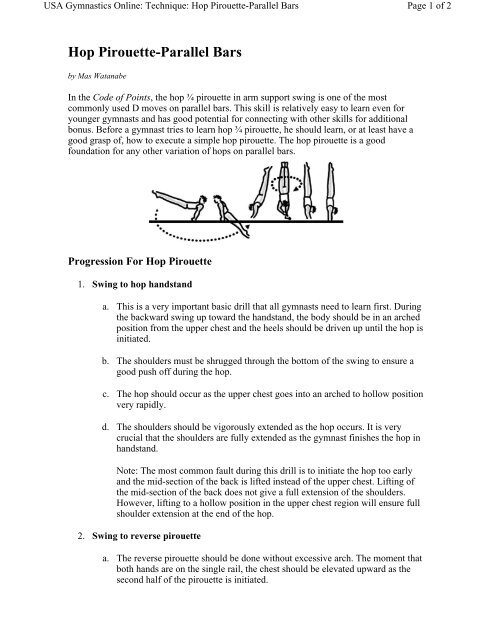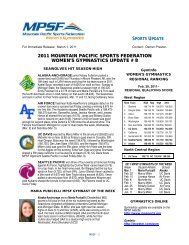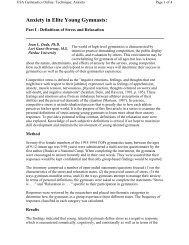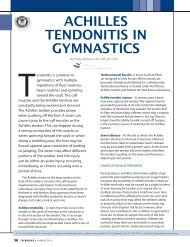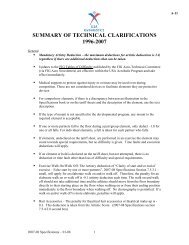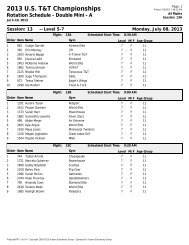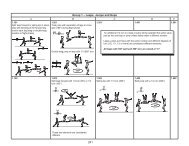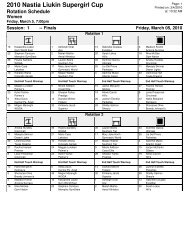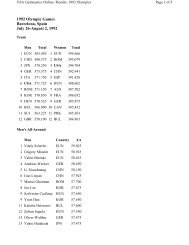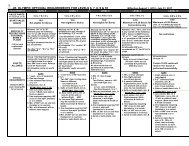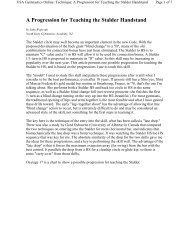Hop Pirouette-Parallel Bars - USA Gymnastics
Hop Pirouette-Parallel Bars - USA Gymnastics
Hop Pirouette-Parallel Bars - USA Gymnastics
Create successful ePaper yourself
Turn your PDF publications into a flip-book with our unique Google optimized e-Paper software.
<strong>USA</strong> <strong>Gymnastics</strong> Online: Technique: <strong>Hop</strong> <strong>Pirouette</strong>-<strong>Parallel</strong> <strong>Bars</strong><br />
<strong>Hop</strong> <strong>Pirouette</strong>-<strong>Parallel</strong> <strong>Bars</strong><br />
by Mas Watanabe<br />
In the Code of Points, the hop ¾ pirouette in arm support swing is one of the most<br />
commonly used D moves on parallel bars. This skill is relatively easy to learn even for<br />
younger gymnasts and has good potential for connecting with other skills for additional<br />
bonus. Before a gymnast tries to learn hop ¾ pirouette, he should learn, or at least have a<br />
good grasp of, how to execute a simple hop pirouette. The hop pirouette is a good<br />
foundation for any other variation of hops on parallel bars.<br />
Progression For <strong>Hop</strong> <strong>Pirouette</strong><br />
1. Swing to hop handstand<br />
a. This is a very important basic drill that all gymnasts need to learn first. During<br />
the backward swing up toward the handstand, the body should be in an arched<br />
position from the upper chest and the heels should be driven up until the hop is<br />
initiated.<br />
b. The shoulders must be shrugged through the bottom of the swing to ensure a<br />
good push off during the hop.<br />
c. The hop should occur as the upper chest goes into an arched to hollow position<br />
very rapidly.<br />
d. The shoulders should be vigorously extended as the hop occurs. It is very<br />
crucial that the shoulders are fully extended as the gymnast finishes the hop in<br />
handstand.<br />
Note: The most common fault during this drill is to initiate the hop too early<br />
and the mid-section of the back is lifted instead of the upper chest. Lifting of<br />
the mid-section of the back does not give a full extension of the shoulders.<br />
However, lifting to a hollow position in the upper chest region will ensure full<br />
shoulder extension at the end of the hop.<br />
2. Swing to reverse pirouette<br />
a. The reverse pirouette should be done without excessive arch. The moment that<br />
both hands are on the single rail, the chest should be elevated upward as the<br />
second half of the pirouette is initiated.<br />
Page 1 of 2
<strong>USA</strong> <strong>Gymnastics</strong> Online: Technique: <strong>Hop</strong> <strong>Pirouette</strong>-<strong>Parallel</strong> <strong>Bars</strong><br />
b. When the reverse pirouette is learned well, it is a good idea to extend the<br />
pirouette to a full pirouette instead of just a half pirouette. An additional half<br />
turn should be added on the single rail.<br />
3. <strong>Hop</strong> pirouette with a spot<br />
A hop pirouette should be initiated as a reverse pirouette hopping backward instead of<br />
forward. In other words, the shoulders going forward should not initiate the hop<br />
pirouette. If a gymnast can make a hop pirouette in the same spot on the bar, or can<br />
release his hands simultaneously, the hop pirouette is done well.<br />
<strong>Hop</strong> ¾ <strong>Pirouette</strong><br />
1. Swing hop handstand<br />
Make sure that the each hop is done correctly with the proper body position.<br />
2. <strong>Hop</strong> ¼ turn to single bar in mixed grip with a spot.<br />
a. This is a simple drill but an important one. The hand of the axis arm should be<br />
turned to an under grip and the other hand is in over grip when hopping to a<br />
single bar.<br />
b. The shoulders must be well extended and the rest of the body is straight over<br />
the shoulders.<br />
3. <strong>Hop</strong> ¼ turn to single bar in mixed grip then, ½ turn with a spot.<br />
a. Simply add the ½ turn after the first hop ¼ pirouette.<br />
The second ½ pirouette should be initiated after the straight body position is<br />
secured in the mixed grip position on the single rail.<br />
b. There should be a slight hesitation prior to the second pirouette. Once<br />
consistency is achieved, the pause between the first ¼ hop pirouette and the<br />
second ½ pirouette should be shortened.<br />
c. When the above drill becomes consistent, the first hop ¼ turn pirouette should<br />
be caught almost with the one shoulder of the under grip arm. That will require<br />
slightly more shoulder extension of the axis arm in order to put all the weight<br />
on one shoulder. Then, complete the ½ turn on the axis shoulder. This is a very<br />
delicate transition period. The shoulder extension of the axis arm and the<br />
straightness of the body is absolutely necessary.<br />
d. A spotter should assist less as consistency improves. It is important to note that<br />
checking the technique of the basic swing hop drill should be done throughout<br />
this progression. A typical problem of hopping with a shoulder angle and/or a<br />
too early hop can be corrected by doing the swing hop handstand well.<br />
This article appears in the April 1998 issue of Technique, Vol. 18, No. 4.<br />
Page 2 of 2


